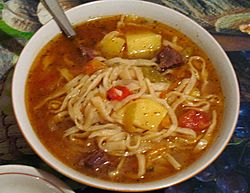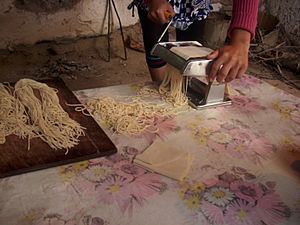Kesme facts for kids

A bowl of kesme soup
|
|
| Alternative names | Reshte, Reshteh |
|---|---|
| Type | Noodle |
| Place of origin | Turkic countries |
| Region or state | Central Asia, West Asia |
| Main ingredients | Flour, water, salt, an egg |
Kesme, also called erişte, is a special kind of egg noodle. You can find it in many Turkic countries, like Turkey, and also in Iran and Afghanistan. In Turkey, it's known as erişte or kesme.
The word "kesme" means "to cut" or "to slice". This name comes from how the dough is cut into noodle strips. Kesme can mean the noodles themselves or a dish made with them. It's usually a homemade meal, not often found in restaurants. In Turkey, people often eat erişte in winter.
Kesme is made from simple ingredients like flour, egg, water, salt, and sometimes milk. These are mixed to make a dough. The dough is rolled out, cut into strips, and then dried. It can be dried in the sun or in an oven.
Contents
How Kesme Noodles Are Made
Making kesme noodles starts with a dough. This dough is usually made from flour, water, salt, and an egg. First, the dough is rolled out into a big, thin circle. Then, it's left to dry for a little while.
After drying, the dough is lightly floured. It's then folded many times, like an accordion. Finally, it's sliced into thin strips, which are then separated. This whole process is done step-by-step.
You can cook the kesme noodles right away. They are often boiled in a tasty broth. This broth might have ingredients like potatoes, meat, carrots, peppers, and tomatoes. Or, the noodles can be left to dry completely and stored for later. Kesme is often cooked in a large pot called a kazan.
What About Reshteh Noodles?
Reshteh (which means "thread" in Persian) are Persian whole wheat noodles. Just like kesme, reshteh noodles were traditionally made at home.
In Iranian cuisine, reshteh can be a thicker, whole wheat noodle. It's used in dishes like reshteh polow (a rice and noodle dish) and ash reshteh (a noodle soup). In old cookbooks from the 1200s and 1300s, "reshteh" was the main word for noodles. If you don't have reshteh, you can often use linguine or other whole-wheat noodles instead.
Reshteh Polow: A Special Dish
Dishes with noodles have a special meaning in Iran. They are often eaten when someone is making an important decision or going through a big change. The noodles are like the "reins" of one's life, showing that you are taking control.
A traditional dish in Iran is reshteh polow. This dish is served during the Persian New Year. The noodles in reshteh polow represent the threads of life and family, all woven together. Noodles are also used in special dishes to give thanks or for journeys, especially to Mecca. In reshteh polow, the noodles are broken into pieces, fried until they are brown, and then added to rice.
Kesme in Factories
In Turkey, kesme noodles are also made in large factories. When they are mass-produced, they are called Erişte.
Gallery
See also
 In Spanish: Erishte para niños
In Spanish: Erishte para niños





